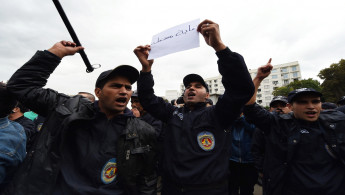Governing, one riot at a time
In mid-October, Algeria’s public order police force did something it has never done before: it went on strike. In fact, it also broke the law because the police force is prohibited from striking to ensure that public order is maintained.
Nor has it been alone in undertaking such action; in January and again in March this year, the Gardes Communaux – the paramilitary force created to back up the army during Algeria’s civil war in the 1990s – mounted mass demonstrations across the country, including in the capital, Algiers, where demonstrations are forbidden.
They were protesting the threatened dissolution of the force and President Abdelaziz Bouteflika’s proposed fourth mandate as president, and demanding better conditions of service and salary increases. In the end, the government bought them off with some of its well-stocked foreign currency reserves (almost US$200 billion at the end of 2013). The police, however, were also complaining about their own commander, General Abdelghani Hamel, and about an on-going crisis in the
| The police demonstrations may have ended but the crisis has not. |
Mzabi centre of Ghardaia, deep in the Sahara desert and close to the major Algerian gas production site at Hassi R’Mel.
Beyond this, both the police action and the Gardes Communaux crisis highlight a growing problem in the day-to-day administration of Algeria where local (and national) government is taking an increasingly hands-off attitude towards social problems. The result is that the population, in turn, responds to official indifference with violence; riots are the way in which local grievances ultimately excite official attention. In 2010 there were over 9,700 riots, according to the leader of the Rassemblement Culturelle et Démocratique (RCD), Said Sadi, and the number has certainly not diminished over the intervening years.
The slightest incident can set off a riot. Typically, quarrels over the distribution of new housing – an endless source of complaint in a country where there is a chronic shortage of housing despite massive government programmes to build a million new housing units – is a common cause. The arrest of youths demonstrating over a lack of jobs would be another. Complaints over government land clearance schemes form a third. And so the list goes on; any hiatus in government response inevitably provokes local violence, often led by unemployed youth seeking to protest their wider frustrations. Riots have now become so common that the process even has a name as far as government officials are concerned – ‘le gestion démocratique des foules’ (the democratic management of crowds).
The police strike and Ghardaia
The police strike is rather more significant, however. It was sparked off by a crisis in Ghardaia at the end of 2013 and, by mid-2014, when the Algerian government claimed the crisis was over, ten people had died and 1,400 houses and shops had been destroyed in Ghardaia itself, the largest of the five towns that make up the Mzab. The Algerian courts had sentenced fifteen people for taking part in the riots the previous March and thousands of anti-riot police had been dispatched to the region to keep the peace.
It is still not clear what sparked off the clashes between the Mzabi population and surrounding Arab settlers who have increased in numbers in recent years. One explanation has been competition over scarce desert pasture between the traditionally nomadic Cha’amba tribes and the sedentary Mzabis. Another suggested that Salafi groups, inspired by the Libyan revolution, had challenged the traditional Ibadi Mzabi leadership in an urban mosque. Finally, there were rumours that the fell hand of the security services, the Direction des Renseignements de Securité (DRS) was behind the clashes, having provoked them to discredit the Bouteflika presidency in the run-up to new presidential elections in which the ailing president was to seek (and win) a fourth mandate.
The public order police, however, clearly did not agree with the government that the crisis was over, for on October 13 1,500 of them demonstrated in Ghardaia, protesting that the crisis there needed a political, not a criminal solution. They demanded and obtained an audience with the prime minister, Abdelmalek Sellal, and the interior minister, Taieb Belaiz, who is directly responsible for the police service.
Amongst their other complaints was an open attack on their own leadership, headed by General Hamel who they accused of incompetence. Their complaints were rammed home by a police demonstration in Algiers itself, in front of the presidency. They also demanded better conditions of employment and the right to form a trade union, at the same time insisting that senior civil servants should respect their powers – apparently they use their positions to claim immunity from prosecution for offences they commit, to immense police annoyance.
The police demonstrations may have ended but the crisis has not. The government has not yet persuaded the protestors to abandon their demands or convinced them that the concessions it has proposed address their complaints.
In fact, the strike is of massive political significance, for it calls into question the legitimacy of both the government and Algeria’s presidency. If it cannot rely on the police as its first line of defence against popular unrest, the outlook for the viability of the Algerian state will be called into question. And that will disquiet the opaque centres in the country where real power resides – ‘Le Pouvoir’ and ‘Les Decideurs’ in the army and the security services.
The outlook for the Bouteflika presidency, in short, is not good as it enters its fourth mandate and Algeria celebrates its sixtieth year of independence.



